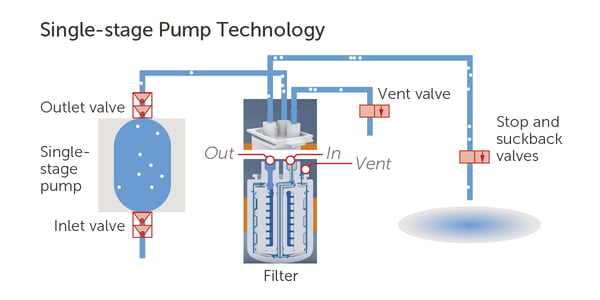Photochemicals are playing an increasingly important role in bringing next generation devices to reality. While semiconductor manufacturing has always needed a pure, contamination-free environment, the requirements are tightening even further.
 |
The solution to maintaining a safe and contamination-controlled chemical delivery environment in the fab is to seek out simplified single-sourced chemical packaging, filtration, and handling products that will increase product yield and reduce financial loss. To ensure an optimized end-to-end process, it is important to take a close look at each stage of the chemical supply chain. While it may seem insignificant, the right clean photochemical delivery pump can make or break the entire chain. Knowing what to look for in a pump is just one step in making the right choice in photochemical delivery. Collaboration across the photolithography supply chain is critically important to achieve clean chemical delivery from point of manufacture to point of dispense.
The key to maintaining chemical purity and dispense chemistries of varying viscosities lies in the delivery system pump technology. Unfortunately, several pump options come with a host of challenges that prevent the ideal process environment.
In some single-stage pumps, dispense occurs through the filter. This impacts the pumps dispense performance with regard to timing and volume. Essentially, the dispense rate is only as fast as the filtration rate. Therefore, the throughput of the track could be limited by the rate of the pump.
 |
A two stage-pump does not dispense chemistry through a filter, rather it separates filtration and dispense so they are independent functions. This allows for higher repeatability without sacrificing filtration quality. A two-stage dispense system provides several key features such as low-filtration rate, pressure control, and unique sequential flow for efficiently removing bubbles.
 |
Further discussion Includes:
- The Impact on Chemical Delivery Systems
- Dispense System Challenges
- What to Look for in a Dispense Pump
- Filtration
- Supply Chain Collaboration
Semiconductor designers continue to innovate to achieve node scaling at 5 nm and below, leveraging 3D architectures to build logic and memory devices. These devices are in high demand to address emerging applications, like artificial intelligence (AI), 5G network connectivity, autonomous transportation, and smart manufacturing. Today's photochemical dispense pumps are designed to meet the challenges of 3D architectures.
Interested in learning more? www.entegris.com/ccd-pumps




